Shopify Plus is Shopify’s most advanced plan, designed to meet the needs of Shopify’s most demanding enterprise-level customers, including AllBirds, GymShark, Huel, and Simba amongst others.
The key benefits of Shopify Plus lie in its ability to handle large volumes of transactions, thereby making it suitable for larger eCommerce stores.
Shopify Plus isn’t cheap – its pricing reflects its enterprise-level status, and pricing typically starts from $2,000 onwards. That puts it firmly out of the domain of most Shopify customers, however it’s important to consider the benefits of that investment. In this post we do just that, outlining some key considerations when jumping to Shopify Plus from another Shopify plan – or indeed, other eCommerce platforms such as Magento.
Sign up to our free Google Ads email course.
7 days, 7 lessons. Everything from how to structure your Google Smart Shopping campaigns to ad testing, and YouTube ads excellence. Sign up and level up your Google Ads eCommerce game.
What are the benefits of Shopify Plus?
Shopify Plus is an enterprise-level solution, designed for merchants that need more features, more control and more robust performance. There are several important benefits to consider when benchmarking Shopify Plus against “standard” Shopify plans.
Shopify Plus Benefits: Custom Checkout Pages
There are several benefits of Shopify being a fully-hosted platform, such as blazing-fast speed and added convenience of not having to host your own store. However, on the flipside, it means that developers don’t have access to Shopify’s underlying code, which makes customising the checkout experience all-but-impossible.
However, Shopify Plus customers have greater control over the default two-step checkout, meaning that merchants can adopt a one-page checkout or any other variation. This means that consumers can shop without ever noticing that they’re on a Shopify-hosted store – a significant benefit for brand-conscious eCommerce merchants that value an end-to-end experience.
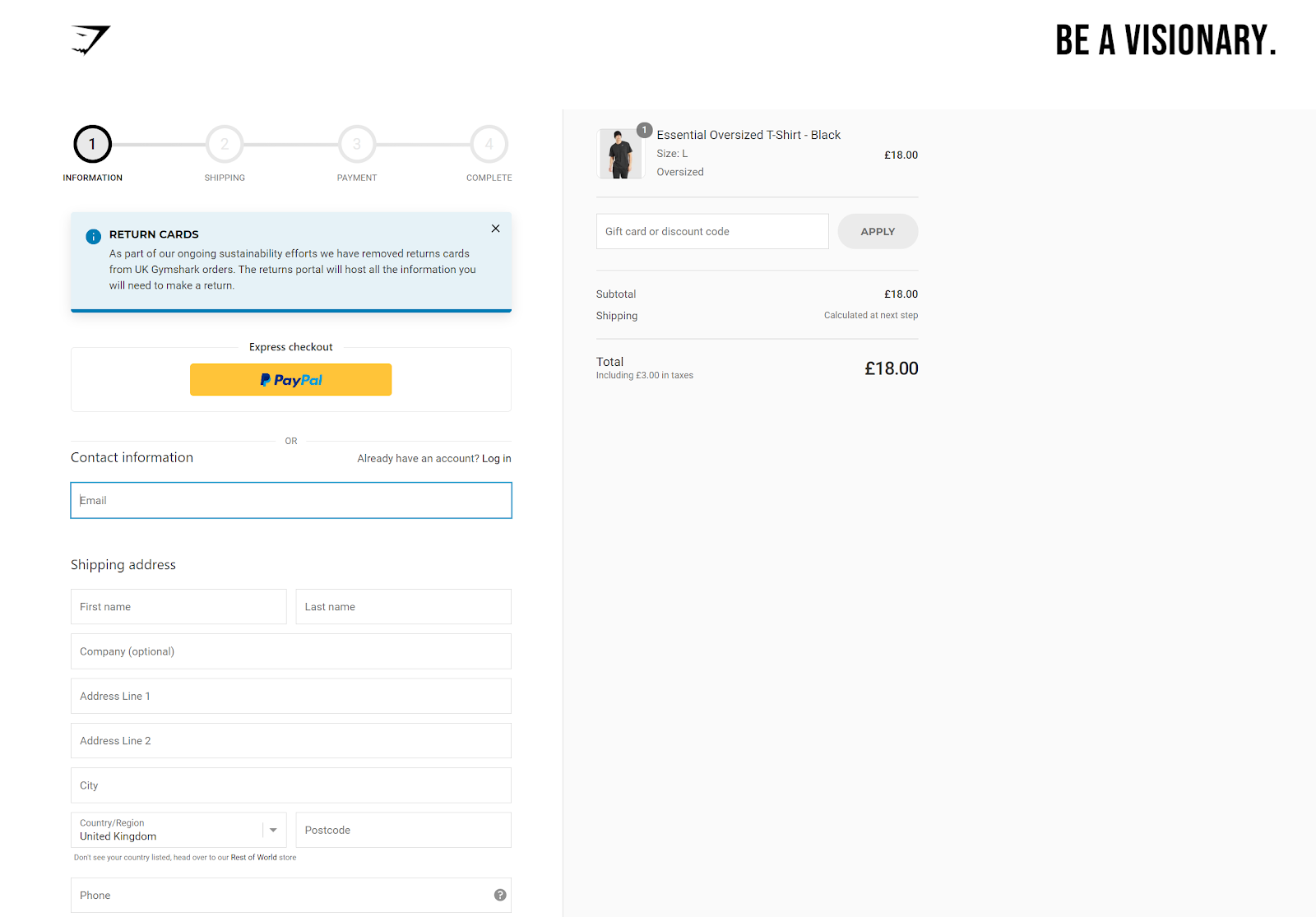
Shopify Plus Benefits: Higher API Call Limits
An API – Application Programming Interface – is a common web protocol that enables the requesting, receiving and sending of data between different programmes. An API call occurs whenever an app takes an action that requires Shopify-powered data, such as customer data.
In order to preserve the integrity of its server load, Shopify limits the number of API calls per second. This can lead to a slightly laggier user experience, particularly if you’re working with third-party Shopify apps that rely on the Shopify API to gain access to data that’s not readily accessible otherwise.
For Shopify Plus brands, the cap on API call limits is increased from the default limit of 40 requests at once to 80.
Shopify Plus Benefits: Dedicated Account Management
For high-volume merchants, likely generating millions of dollars in revenue every year, high-touch customer support is a necessity. After all, this is your storefront, and any issues leading to store downtime can have a devastating impact on your bottom-line.
Thankfully, Shopify Plus merchants can benefit from Shopify’s Merchant Success Programme. Whilst it isn’t easy putting a value on something as intangible as customer support, the real benefit here is piece-of-mind. They offer a 24/7 access line to Shopify Plus specialists, to help put out fires wherever they may appear.
If you’re migrating over from another platform, such as BigCommerce or Magento, they also boast an industry-leading on-boarding experience, with the help of technical “Launch Engineers” who can help you migrate with the minimum of fuss.
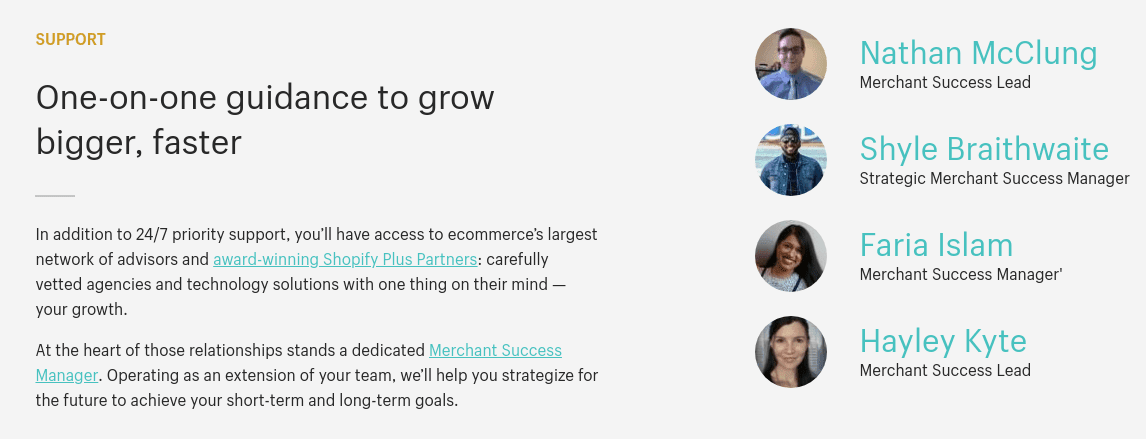
Shopify Plus Benefits: Launchpad
Launchpad is an app offered by Shopify, for Shopify Plus customers who want to set up and track automated campaign events at scale – think flash sales and product launches.
Using Launchpad, merchants can easily set up schedules for large-scale price changes, in order to create sale events. Launchpad can even update your theme during a given time period, which is a perfect automated solution for holiday events and other seasonal periods.
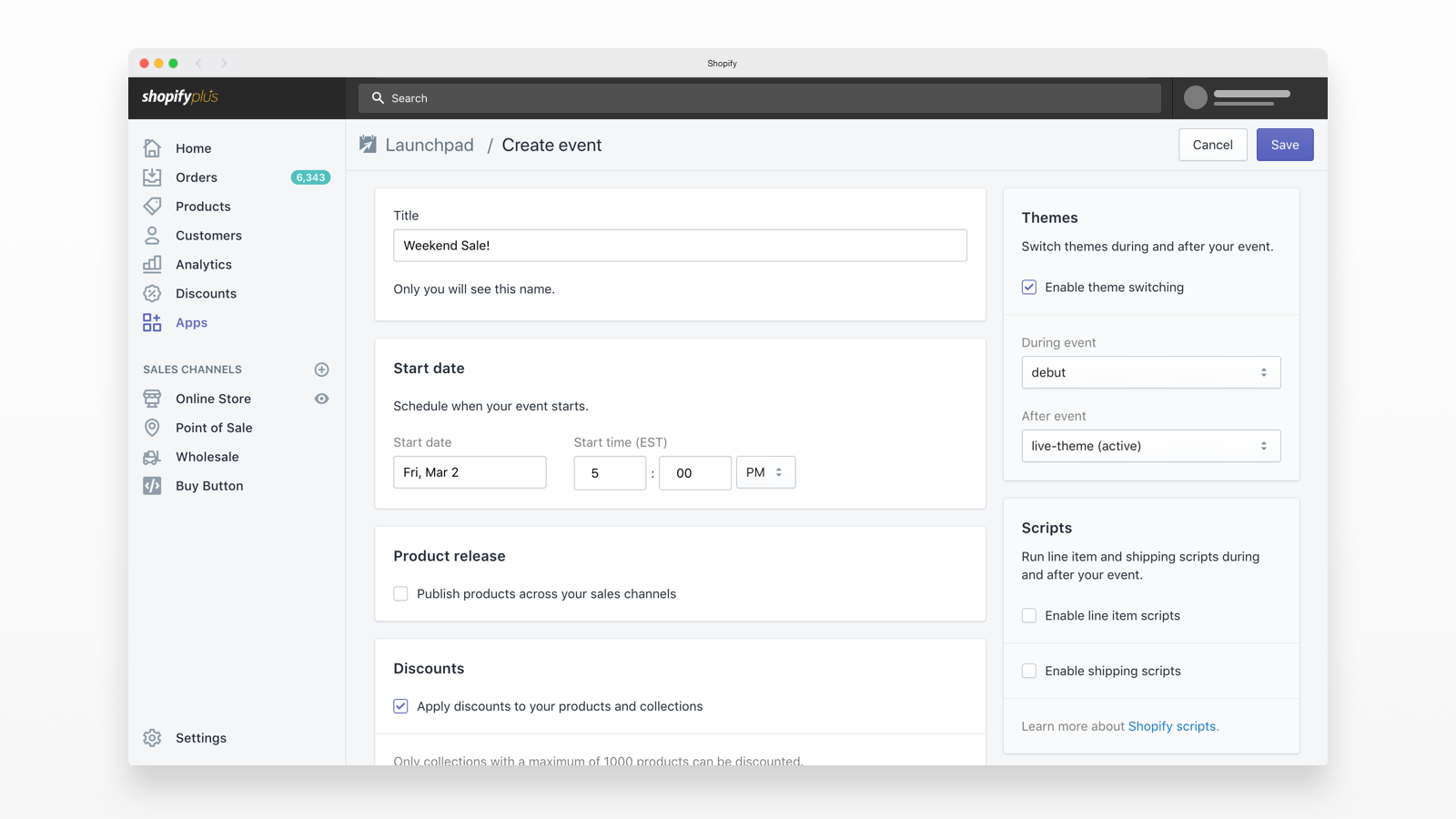
Shopify Plus Benefits: Shopify Scripts
There are a plethora of third-party Shopify apps out there that can amend product pricing based on “if-then” logic to offer discounts and free shipping, however these can be clunky and difficult to customise to an acceptable level for enterprise users. Furthermore, a reliance on third-party apps can significantly slow down the performance of your store, thereby compromising conversion efficiency.
Enter Shopify Scripts, a surprisingly straightforward solution to apply percentage, fixed amount, and bulk-buy discounts. Merchants can apply discounts based on:
- Total basket value
- Product quantity
- A combination of items purchased together
- Specific discounts applied to customer tags, e.g. new customers, VIPs
For the average eCommerce Manager, writing scripts may seem like an intimidating thought, however with the Script Editor app for Shopify Plus merchants, it’s more intuitive than you might expect. Coupled with this, there are a number of templates available to help get you started, directly from Shopify help.

Shopify Plus Benefits: Shopify Flow
Shopify Flow is another native Shopify app that allows Shopify Plus merchants to leverage the power of automation to complete everyday operational tasks – think of it as a supercharged version of Zapier, built specifically for Shopify.
Automated workflows can be either built from scratch, or chosen from a template library. Some popular use cases include:
- Tag products based on inventory level
- Set up internal reminder emails when stock falls below a certain level
- Temporarily remove out-of-stock products from being shown on store
- Republishing products when inventory is back in stock
- Set up internal reminder emails when stock falls below a certain level
- Add tags to customers based on shopping behaviour
- Creating a triggered action whenever a high-risk order is detected
If you’re still using Microsoft Excel to track and manage your operational processes, Shopify Flow can help to bring you into the 21st century!
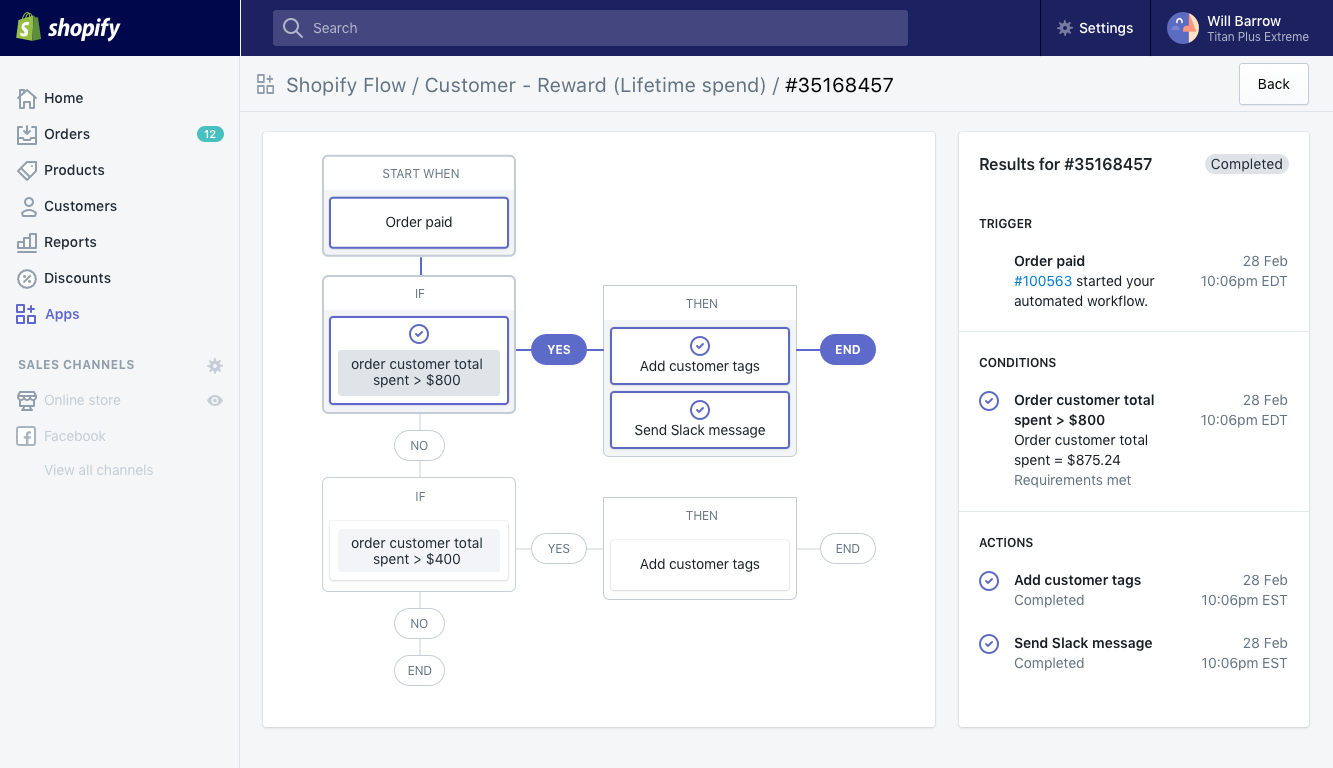
How does Shopify Plus compare to Magento?
If you’re considering moving over to Shopify Plus from Magento, or indeed another eCommerce platform, it’s worth considering how they compare across three key areas: internationalisation, ecosystem, and maneuverability for Search Engine Optimisation.
Shopify Plus vs. Magento: Internationalisation
Magento’s enterprise-level solution has a number of great features for merchants with a multi-store architecture. Although Shopify Plus is taking important steps forward in this respect, it’s widely considered to be behind the curve when it comes to scaling stores globally.
For example, Shopify allows you to clone stores in order to extend reach across multiple geographies. However, that functionality only allows you to clone certain aspects of your store installation, and it now pushes merchants to use it’s multi-currency functionality instead. This involves taking advantage of the in-built geolocation detection to identify where users are coming from, and then displaying prices in the local currency (rounding up prices so that they don’t appear to look like a random set of numbers). The obvious benefits here are that the user experience is pretty slick, and merchants only need to manage one site as opposed to many.
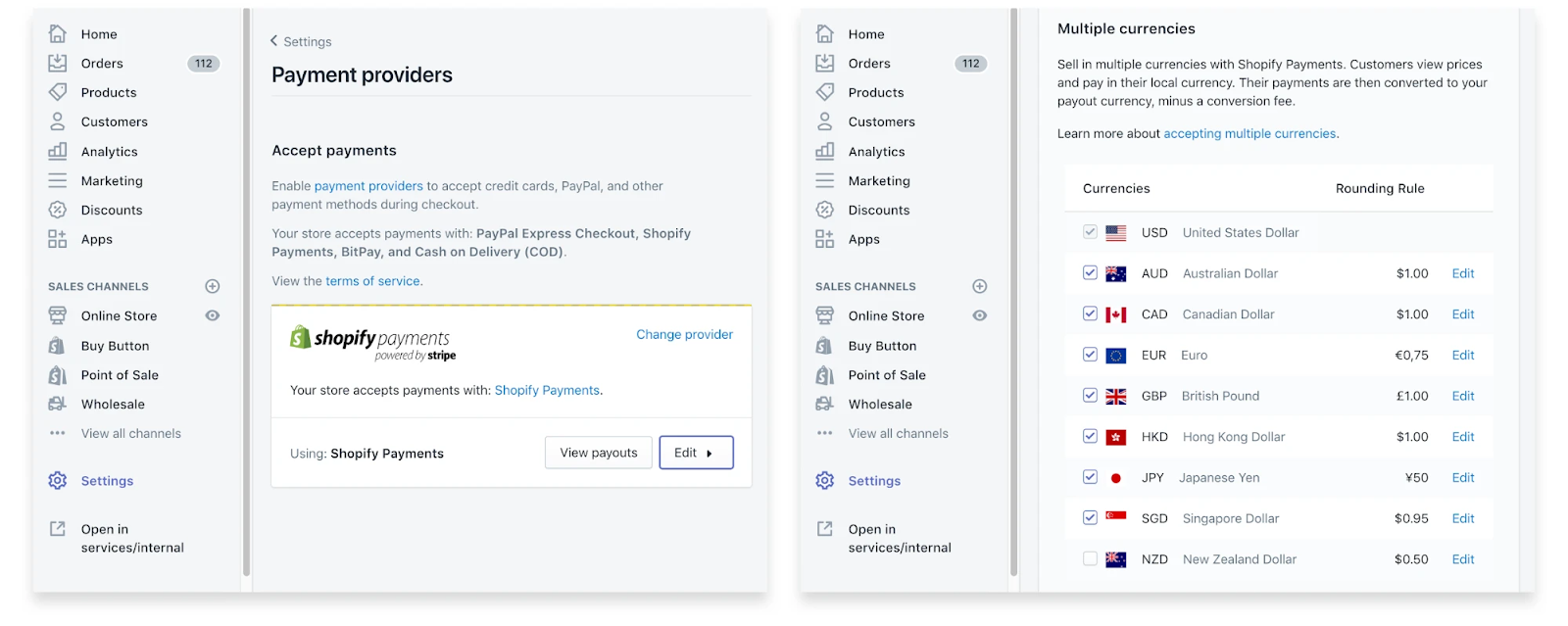
However, there are some drawbacks, in that not all third-party Shopify apps are compatible with multi-currency, and prices may fluctuate in line with exchange rates (which may cause some confusion with returning customers in particular).
While the multi-currency approach may solve (at least partially) the challenge of currency conversion, it doesn’t solve the issue of language. For most DTC brands, speaking in the same language of your customer is central to conveying your core brand meaning, so without third-party translation apps, a single store approach is unlikely to cut it. Therefore, a multi-store architecture is likely to be beneficial for Shopify merchants serving global customers – however, this approach can be clunky to set up, and still requires a lot of manual heavy-lifting in regards to managing apps, promotions, shipping, merchandising, and customer data.
Magento on the other hand, is built firmly with global scale in mind. You can create multiple stores in just a single installation, reducing the need to duplicate functionality across markets. You can also manage attributes “globally”, allowing you to make changes to stock, pricing, imagery, and other attributes at scale, across multiple geographies. With Shopify, the process is more manual, as you’d need to clone your stores and update each individually.
Although Shopify is making strides here, Magento comes out on top thanks to its intuitive multi-store architecture.
Shopify Plus vs. Magento: Ecosystem
One of Shopify’s strongest suits is its pre-vetted community of apps, many of which integrate seamlessly. For example, you can sync your customer purchase data to automate email sequences using Klaviyo. Or, you can integrate your data with a customer experience app like Giorgas, so that your live chat representatives can see all of your customer’s purchase history when initiating on-site conversations. These are just two examples of integration in practice, but there are hundreds of other potential use cases, all of which add up to a pretty slick customer experience.
For merchants too, the benefits of Shopify’s ecosystem cannot be understated. Rather than spending hundreds of thousands of dollars to build a scalable loyalty program, retailers can set up an advanced program complete with membership tiers, points, and rewards, in a matter of hours using a cost-effective solution like Smile.io. The same can be said across other areas such as customer support (Giorgias), subscriptions (ReCharge), and on-site search (Klevu). Shopify apps are also vetted before becoming part of its’ App Store, which ensures quality of ecosystem and preserves platform stability.
In terms of app ecosystem size, Magento dwarves Shopify, with around 5,000 app extensions available. However, quantity is not everything, and it lacks the extensive approval process of Shopify, which ultimately is where the heart of this comparison lies – with Magento, due to its open-source nature, a software update can potentially break a plugin and bring your store down – with Shopify this is much less likely to happen as issues are quickly flagged from within the Merchant community, prompting developers to continuously drive development.
In terms of quality and robustness, we’ll have to give this one to Shopify.

Shopify Plus vs. Magento: Search Engine Optimisation
In terms of basic SEO, both platforms cover all the bases. Shopify’s out-of-the-box search engine optimisation capabilities are much-improved, allowing merchants to utilise custom page URLs, meta descriptions, image alt tags, and more. However, due to the locked down nature of its underlying codebase, it’s not easy to apply more advanced optimisation techniques.
Magento initially requires a lot of work to get up-to-speed, from an SEO perspective. But assuming that you’ve got a capable developer, the optimisation ceiling is higher, as the open source platform provides more flexibility – for example, it’s pretty straightforward to create rich snippets, and fine-tune a website robot.txt file.
Magento is the winner here, primarily due to fundamental differences in accessibility to the underlying code.
Bottom-line: Is Shopify Plus worth it?
Good question. The answer is – it depends.
DO migrate to Shopify Plus if you value automation.
Shopify Plus has some clear benefits of both Standard Shopify plans and Magento when it comes to automation of operational processes. If you value making things run without manual input, then Shopify Plus is a worthwhile investment. Not only can you use Shopify Flow to create notifications based on “if-then” logic, but you can also use these automated sequences to tag customers based on specific behaviours, which opens up new possibilities for lifecycle marketing.
DO migrate to Shopify Plus if you value platform support.
Migrating to a new platform invariably comes with teething problems. Having dedicated Account Management and technical support, can help to iron out any pre and post-launch niggles. With Magento, you’re very much on your own, although there is of course a passionate developer community that can help to overcome roadblocks.
But the same goes with Shopify. Sometimes, a bit of hand-holding is precisely what’s required to give you peace of mind.
DO migrate to Shopify Plus if you value a world-class ecosystem.
Shopify’s ecosystem is a big pull. A fully-vetted directory of apps that can plug into your site seamlessly is a draw that other eCommerce platforms simply can’t compete with.
There are also Shopify Plus-only apps which can help deliver complex customer experiences in a cost-effective way. If you’re migrating from another Shopify plan, this fact alone can be a compelling reason to upgrade, given that some of these apps will only work if you’re on the Plus plan.


